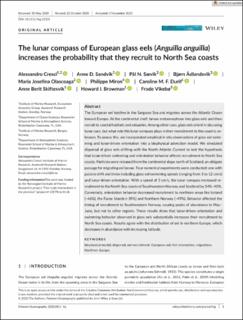| dc.description.abstract | The European eel hatches in the Sargasso Sea and migrates across the Atlantic Ocean toward Europe. At the continental shelf, larvae metamorphose into glass eels and then recruit to coastal habitats and estuaries. Among other cues, glass eels orient in situ using lunar cues, but what role this lunar compass plays in their recruitment to the coast is unknown. To assess this, we incorporated empirical in situ observations of glass eel swimming and lunar‐driven orientation into a biophysical advection model. We simulated dispersal of glass eels drifting with the North Atlantic Current to test the hypothesis that lunar‐driven swimming and orientation behavior affects recruitment to North Sea coasts. Particles were released from the continental slope north of Scotland, an obligate passage for migrating eel larvae. Four numerical experiments were conducted: one with passive drift and three including glass eel swimming speeds (ranging from 3 to 12 cm/s) and lunar‐driven orientation. With a speed of 3 cm/s, the lunar compass increased recruitment to the North Sea coasts of Southwestern Norway and Scotland by 34%–40%. Conversely, orientation behavior decreased recruitment to northern areas like Iceland (−46%), the Faroe Islands (−39%) and Northern Norway (−49%). Behavior affected the timing of recruitment to Southwestern Norway, causing peaks of abundance in May–June, but not to other regions. These results show that lunar‐driven orientation and swimming behavior observed in glass eels substantially increases their recruitment to North Sea coasts. Results agree with the distribution of eel in northern Europe, which decreases in abundance with increasing latitude. | en_US |
